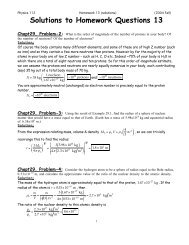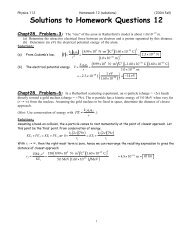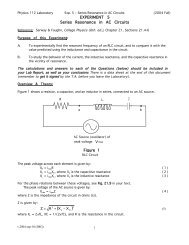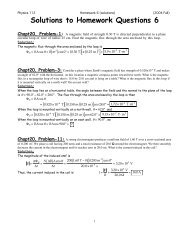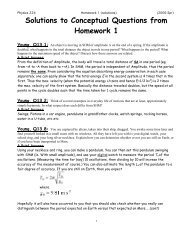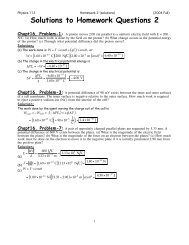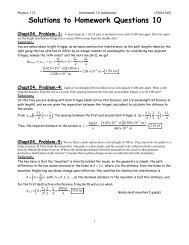Solutions to Homework Questions 3
Solutions to Homework Questions 3
Solutions to Homework Questions 3
You also want an ePaper? Increase the reach of your titles
YUMPU automatically turns print PDFs into web optimized ePapers that Google loves.
Physics 112 <strong>Homework</strong> 3 (solutions) (2004 Fall)<br />
<strong>Solutions</strong> <strong>to</strong> <strong>Homework</strong> <strong>Questions</strong> 3<br />
Chapt17, Problem-1: If a current of 80.0 mA exists in a metal wire, how many electrons flow past<br />
a given cross section of the wire in 10.0 min? Sketch the directions of the current and the electrons’ motion.<br />
Solution:<br />
The charge that moves past the cross section is !Q = I (!t), so given the charge on a single electron, we<br />
can calculate the number of electrons passing through a the given cross-section as being<br />
( )<br />
n = !Q e<br />
= I !t<br />
e<br />
( ) 10.0 min<br />
= 80.0 !10 "3 C s<br />
[( )( 60.0 s min )]<br />
1.60! 10 -19 C<br />
= 3.00! 1020 electrons<br />
Note that since we are asked for the number of electrons, we can ignore the fact that the electrons are<br />
actually negatively charged.<br />
For the sketch, simply remember that the negatively charged electrons move in the direction opposite <strong>to</strong><br />
the conventional current flow.<br />
Chapt17, Problem-5: In the Bohr model of the hydrogen a<strong>to</strong>m, an electron in the lowest energy<br />
state moves at a speed of 2.19x10 6 m/s in a circular path having a radius of 5.29x10 –11 m. What is the<br />
effective current associated with this orbiting electron?<br />
Solution:<br />
We are going <strong>to</strong> use the fact that current is amount of charge ‘flowing’ past in a given time. However the<br />
key word <strong>to</strong> spot here is ‘circular’ – the electron can be thought of as orbiting the pro<strong>to</strong>n at the center of<br />
the a<strong>to</strong>m.. The period of the electron in its orbit is T = 2!r v (distance around the orbit divided by the<br />
speed at which it is moving – review PHYS111 if you are unsure of Circular motion). So the current<br />
represented by the orbiting electron is<br />
I = !Q<br />
!t = e T = ve<br />
2"r<br />
(<br />
= 2 .19! 106 ms) ( 1.60! 10 "19 C )<br />
= 1.05 !10 "3 Cs= 1.05 mA<br />
2 # 5.29 !10 "11 m<br />
( )<br />
Again we can ignore the fact that the electrons are actually negatively charged since we are asked for the<br />
current.<br />
Chapt17, Problem-8: An aluminum wire with a cross-sectional area of 4.0x10 –6 m 2 carries a<br />
current of 5.0 A. Find the drift speed of the electrons in the wire. The density of aluminum is 2.7 g/cm 3 .<br />
(Assume that one electron is supplied by each a<strong>to</strong>m.)<br />
Solution:<br />
Using the assumption (that the question tells us <strong>to</strong> make) that each aluminum a<strong>to</strong>m contributes one<br />
electron, then the density of charge carriers is the same as the number of a<strong>to</strong>ms per cubic meter. This is<br />
density<br />
n =<br />
mass per a<strong>to</strong>m = !<br />
= N A !<br />
M N A<br />
M ,<br />
(<br />
or n = 6.02 !1023 mol) [( 2.7 g cm 3<br />
)10 ( 6 cm 3 1 m 3<br />
)]<br />
= 6.0 !10 28 m 3<br />
26.98 g mol<br />
1
Physics 112 <strong>Homework</strong> 3 (solutions) (2004 Fall)<br />
So we can now use the equation for the drift speed of the electrons <strong>to</strong> get<br />
I<br />
v d =<br />
neA =<br />
5.0 C s<br />
( 6.0! 10 28 m 3<br />
)1.60 ( ! 10 "19 C )( 4.0 !10 "6 m 2<br />
) = 1.3!10 "4 ms<br />
We can ignore the fact that the electrons are actually negatively charged since we are asked for a speed<br />
Chapt17, Problem-11: A person notices a mild shock if the current along a path through the<br />
thumb and index finger exceeds 80 µA. Compare the maximum allowable voltage without shock across the<br />
thumb and index finger with a dry-skin resistance of 4.0x10 5 ! and a wet-skin resistance of 2 000!<br />
Solution:<br />
This is a straightforward application of Ohm’s Law. Let ("V) max be the maximum voltage before a person<br />
feels the shock, then<br />
(!V) max<br />
= I max R = ( 80 "10 #6 A)R<br />
Thus, if R = 4.0 ! 10 5 " , (!V) max<br />
= 32 V ,<br />
but the skin is wet, and R = 2000 !, (!V) max<br />
= 0.16 V<br />
Chapt17, Problem-12: Suppose that you wish <strong>to</strong> fabricate a uniform wire out of 1.00 g of copper.<br />
If the wire is <strong>to</strong> have a resistance of R = 0.500!, and if all of the copper is <strong>to</strong> be used, what will be (a) the<br />
length and (b) the diameter of this wire?<br />
Solution:<br />
This is a little harder. The question does not supply all the information required, and you are required <strong>to</strong><br />
realize what pieces of information are missing. .[I would give you all the information in a Quiz or Exam !]<br />
However there is a strong hint in the question: you are given the mass of the material, and are required <strong>to</strong><br />
calculate the area & length – these last two give a volume, and mass and volume are related through<br />
density. Furthermore resistance, cross-sectional area & length are related through the resistivity of a<br />
material. Thus the missing information is actually the density of copper (which is given in Ex17.2 in the<br />
text), and the resistivity of Copper (Table 17.1 – since no temperature is given, and the temperature<br />
coefficient of resistivity is small, it is OK <strong>to</strong> assume room-temperature). So armed with these values, first<br />
lets calculate the volume of copper we have at our disposal.<br />
V =<br />
m<br />
density = 1.00! 10 "3 kg<br />
8.92 !10 3 kg m 3 = 1.12 !10 "7 m 3<br />
Now since, V = A!L , this gives A!L = 1.12 "10 #7 m 3 . Lets call that eqn(1)<br />
(a) OK, well we know the resistance we require, and so can find another expression relating the length and<br />
cross-sectional area using R = !L ,. Subsituting in the values, we find<br />
A<br />
"<br />
A =<br />
! % "<br />
$ ' L =<br />
1.70( 10)8 *+m %<br />
# R&<br />
$<br />
' L = ( 3.40( 10 )8 m )L .<br />
# 0.500 * &<br />
So inserting this expression for A in<strong>to</strong> eqn(1) gives<br />
( 3.40 ! 10 "8 m)L 2 = 1.12! 10 "7 m 3 , which yields L = 1.82 m<br />
(b) From eqn(1) we can simply get the area, A = !d2<br />
4 = 1.12" 10#7 m 3<br />
,<br />
L<br />
but note that it is actually the diameter that is asked for in the question, so<br />
( )<br />
d = 4 1.12 !10 "7 m 3<br />
#L<br />
= 2.80 ! 10 "4 m = 0.280 mm<br />
( )<br />
= 4 1.12 ! 10"7 m 3<br />
# 1.82 m<br />
( )<br />
2
Physics 112 <strong>Homework</strong> 3 (solutions) (2004 Fall)<br />
Chapt17, Problem-19: The breathing moni<strong>to</strong>r shown<br />
in the Figure girds the patient with a mercury-filled rubber tube<br />
and measures the variation of the tube resistance. The tube has<br />
an unstretched length of 1.25 m and an inside diameter of 2.51 mm.<br />
The moni<strong>to</strong>r is connected <strong>to</strong> a 100-mV power supply, and the <strong>to</strong>tal<br />
resistance of the circuit is that due <strong>to</strong> the mercury plus 1.00! (an<br />
internal resistance of the power supply). Determine the change of<br />
current through the moni<strong>to</strong>r as a patient draws in a breath and stretches<br />
the hose by 10.0 cm. Take "(Hg) = 9.40x10 –7 ! m.<br />
Solution:<br />
When the tube is stretched, the cross-sectional area decreases.<br />
Since the volume of mercury is constant, we have a simple<br />
Expression relating the initial & final (stretched) dimensions, namely V = A f !L f = A i !L i ,<br />
" !<br />
i.e.<br />
4 d 2 % "<br />
$ f ' L<br />
# & f = ! 4 d i 2 %<br />
$ ' L<br />
# & i . So this gives us d 2 f = d 2 i ( L i L f ).<br />
The <strong>to</strong>tal resistance of the circuit is (the “plus 1.00!” just makes the problem more realistic)”<br />
R = r + R Hg = 1.00 ! + " HgL<br />
A<br />
= 1.00 ! + 4" HgL<br />
#d 2<br />
The change in current through the moni<strong>to</strong>r is (application of Ohm’s Law both before & after)<br />
!I = !V " !V !V<br />
!V<br />
=<br />
R f<br />
R i<br />
=<br />
1.00 #+ 4$ "<br />
2<br />
HgL f<br />
%d 2 i<br />
L i<br />
0.100 V<br />
( ) 1.35 m<br />
( ) 2 1.25 m<br />
1.00 # + 4 9.4& 10-7 #' m<br />
% 2 .51&10 "3 m<br />
1.00 # + 4$ HgL i<br />
%d i<br />
2<br />
( ) 2<br />
( )<br />
"<br />
0.100 V<br />
( ) 1.25 m<br />
%( 2.51 & 10 "3 m) 2<br />
1.00 # + 4 9.4&10 -7 #'m<br />
which can be evaluated <strong>to</strong> finally give !I = " 2.5 #10 "3 A = a 2 .5 mA decrease<br />
( )<br />
Chapt17, Problem-28: A <strong>to</strong>aster rated at 1 050 W operates on a 120-V household circuit and has<br />
a 4.00-m length of nichrome wire as its heating element. The operating temperature of this element is<br />
320°C. What is the cross-sectional area of the wire?<br />
Solution:<br />
The resistance of the heating element when at its operating temperature is<br />
( ) 2<br />
( ) 2<br />
R = !V<br />
" = 120 V<br />
1050 W = 13.7 #<br />
So we have the resistance, and the length – so if we know the resistivity, we can calculate the crosssectional<br />
area of the wire. Now we are also <strong>to</strong>ld an operating temperature, so that should hint that we need<br />
<strong>to</strong> include the temperature dependence of resistivity (using values in Table 17.1)<br />
R = R 0 [ 1 +! ( T " T 0 )]= # 0 L<br />
[<br />
A 1+ ! ( T " T 0 )], so the cross-sectional area is<br />
A = ! 0 L<br />
[<br />
R 1 +" ( T # T 0 )]<br />
( ) 4.00 m<br />
= 150 $ 10#8 %&m<br />
13.7 %<br />
( )<br />
ie. The requested area is A = 4.90! 10"7 m 2<br />
[ 1+ ( 0.40 $10 #3 ( °C ) #1<br />
)( 320°C# 20.0°C)<br />
]<br />
3
Physics 112 <strong>Homework</strong> 3 (solutions) (2004 Fall)<br />
Chapt17, Problem-32: The output power of the Sun is 4.0x10 26 W. Calculate at eight cents per<br />
kilowatt-hour the cost of running the Sun for one second?<br />
Solution:<br />
From the definition of power, the energy produced by the Sun in 1.0 second is<br />
E =!" t = 4.0 # 10 26 W ( )<br />
( ) 1.0 s<br />
Converting this <strong>to</strong> kilowatt-hours (Eqn 17.11) E= 4.0 ! 10 26 # 1 kW & # 1 h &<br />
W"s%<br />
$ 10 3 ( % ( = 1.1! 10 20 kWh<br />
W'<br />
$ 3600 s'<br />
At a rate of 8.0¢ per kilowatt-hour, the cost of this energy is<br />
cost = 1.1 !10 20 " $0.08%<br />
( kWh)<br />
$ ' =<br />
# kWh &<br />
8.8 ! 1018 dollars<br />
Chapt17, Problem-37: What is the required resistance of an immersion heater that will increase<br />
the temperature of 1.50 kg of water from 10.0°C <strong>to</strong> 50.0°C in 10.0 min while operating at 120 V?<br />
Solution:<br />
This is yet another question tht unfortunately required you <strong>to</strong> scramble around the book ssearching out a<br />
piece of information not supplied by the question. In this case, the missing information was the specific<br />
heat of water (which can be found in Table 11.1) and gives the energy required <strong>to</strong> raise the temperature of<br />
1kg of water by 1 o C. Armed with this information, one can simply calculate how much energy we require <strong>to</strong><br />
raise the amount of water specified in the question by the 40 o C requested.<br />
E = mc (!T<br />
)= ( 1.50 kg) 4186 J kg "°C ( )= 2.51 $10 5 J<br />
( ) 50.0°C# 10.0°C<br />
and, if this is <strong>to</strong> be added in !t = 10.0 min = 600 s , the power input needed is<br />
!= E "t = 2.51# 105 J<br />
= 419 W<br />
600 s<br />
The power input <strong>to</strong> the heater may be expressed as != "V<br />
( ) 2<br />
( ) 2<br />
R = !V<br />
" = 120 V<br />
419 W = 34.4 !<br />
( ) 2 R , so the needed resistance is<br />
Chapt17, Problem-41: We estimate that there are 270 million plug-in electric clocks in the United<br />
States, approximately one clock for each person. The clocks convert energy at the average rate of 2.50 W.<br />
To supply this energy, how many metric <strong>to</strong>ns of coal are burned per hour in coal-fired electric-generating<br />
plants that are, on average, 25.0% efficient? The heat of combustion for coal is 33.0 MJ/kg.<br />
Solution:<br />
The <strong>to</strong>tal power converted by the clocks is<br />
!= ( 2 .50 W )( 270 "10 6<br />
)= 6.75 " 10 8 W ,<br />
and the energy used in one hour is<br />
E =!" t = 6.75 # 10 8 W ( )= 2 .43# 10 12 J .<br />
( ) 3600 s<br />
The energy input required from the coal is<br />
E<br />
E coal =<br />
efficiency = 2.43 !1012 J<br />
= 9.72 !10 12 J<br />
0.250<br />
The required mass of coal is thus<br />
E<br />
m =<br />
coal<br />
heat of combustion = 9.72! 1012 J<br />
33.0 ! 10 6 Jkg = 2.95 ! 105 kg<br />
or<br />
"<br />
m = ( 2.95 !10 5 1 metric <strong>to</strong>n %<br />
kg) $<br />
# 10 3 kg<br />
' = 295 metric <strong>to</strong>ns<br />
&<br />
4
Physics 112 <strong>Homework</strong> 3 (solutions) (2004 Fall)<br />
Chapt17, Problem-42: The cost of electricity varies widely throughout the United States;<br />
$0.120/kWh is one typical value. At this unit price, calculate the cost of (a) leaving a 40.0-W porch light on<br />
for two weeks while you are on vacation, (b) making a piece of dark <strong>to</strong>ast in 3.00 min with a 970-W <strong>to</strong>aster,<br />
and (c) drying a load of clothes in 40.0 min in a 5 200-W dryer.<br />
Solution:<br />
E =!" t = ( 40.0 W )( 14.0 d)<br />
24.0 h d<br />
(a)<br />
( )= 1.34# 10 4 Wh = 13.4 kWh<br />
cost = E! ( rate)= ( 13.4 kWh )( $0.120 kWh)= $1.61<br />
(b) E =!" t = ( 0.970 kW )( 3.00 min) ( 1 h 60 min)= 4.85 #10 $2 kWh<br />
cost = E! ( rate)= ( 4.85 !10 -2 kWh) ( $0.120 kWh)= $0.00583 = 0.583 cents<br />
(c) E =!" t = ( 5.20 kW) ( 40.0 min) ( 1 h 60 min)= 3.47 kWh<br />
cost = E! ( rate)= ( 3.47 kWh )( $0.120 kWh )= $0.416 = 41.6 cents<br />
Chapt17, Problem-52: . Birds resting on high-voltage power lines are a common sight. The<br />
copper wire on which a bird stands is 2.2 cm in diameter and carries a current of 50 A. If the bird’s feet are<br />
4.0 cm apart, calculate the potential difference across its body.<br />
Solution:<br />
The resistance of the 4.0 cm length of wire between the feet is<br />
R = !L (<br />
A = 1.7 " 10#8 $%m) ( 0.040 m )<br />
& ( 0.011 m ) 2 = 1.79" 10 #6 $,<br />
so the potential difference is<br />
!V = IR = ( 50 A) ( 1.79 "10 #6 $ )= 8.9 " 10 #5 V =<br />
89 µV<br />
Chapt17, Problem-59: . (a) Determine the resistance of a lightbulb marked 100 W @ 120 V. (b)<br />
Assuming that the filament is tungsten and has a cross-sectional area of 0.010 mm 2 , determine the length of<br />
the wire inside the bulb when the bulb is operating. (c) Why do you think the wire inside the bulb is tightly<br />
coiled? (d) If the temperature of the tungsten wire is 2 600°C when the bulb is operating, what is the length<br />
of the wire after the bulb is turned off and has cooled <strong>to</strong> 20°C? (See Chapter 10, and use 4.5 _ 10 –6 /°C as the<br />
coefficient of linear expansion for tungsten.)<br />
Solution:<br />
(<br />
(a) From != "V ) 2<br />
(!V) 2<br />
( ) 2<br />
, the resistance is R =<br />
R<br />
( b ) Solving R = !L<br />
A<br />
for the length gives<br />
( )<br />
( ) 0.010 mm 2<br />
" = 120 V<br />
100 W = 144 !<br />
L = R! A<br />
" = 144 #<br />
% 1 m 2 (<br />
5.6 $10 -8 '<br />
#!m & 10 6 mm 2 * =<br />
)<br />
26 m<br />
( c ) The filament is tightly coiled <strong>to</strong> fit the required length in<strong>to</strong> a small space<br />
( d ) From L = L 0 [ 1 +! ( T " T 0 )], where ! = 4.5 " 10 #6 °C<br />
L<br />
L 0 =<br />
1+ !( T " T 0 ) = 26 m<br />
1+ 4.5 #10 "6 °C<br />
( ) #1 , the length at T 0 = 20°C is<br />
( ( ) "1<br />
)( 2600°C-20°C) = 25 m<br />
5
Physics 112 <strong>Homework</strong> 3 (solutions) (2004 Fall)<br />
Chapt17, Conceptual-1: A coulomb is a very large unit of charge, and yet currents of several<br />
Amperes are quite common. How is this possible?<br />
Solution:<br />
It is made possible by the extremely high density of charge carriers (~10 28 m -3 ) in metallic conduc<strong>to</strong>rs. A<br />
typical household copper wire is ~1x10 -6 m 2 in cross-sectional area, hence there are ~10 20 potential charge<br />
carriers per cm.<br />
Chapt17, Conceptual-3: Why don’t the free electrons in a metal fall <strong>to</strong> the bot<strong>to</strong>m of the metal<br />
due <strong>to</strong> gravity? And charges in a conduc<strong>to</strong>r are supposed <strong>to</strong> reside on the surface – why don’t the free<br />
electrons all go <strong>to</strong> the surface?<br />
Solution:<br />
The gravitational force pulling the electron <strong>to</strong> the bot<strong>to</strong>m of a piece of metal is much smaller than the<br />
electrical repulsion pushing the electrons apart. Thus, free electrons stay distributed throughout the<br />
metal. The concept of charges residing on the surface of a metal is true for a metal with an excess of<br />
charge. The number of free electrons in an electrically-neutral piece of metal is the same as the number of<br />
positive ions – the metal has zero net charge.<br />
Chapt17, Conceptual-5: Newspaper articles often have statements such as “10 000 volts of<br />
electricity surged through the victim’s body.” What is wrong with this statement?<br />
Solution:<br />
[Abridged/adapted version of answer in the back of the Text] A voltage is not something that “surges<br />
through” a completed circuit. A voltage is a potential difference that is applied across a device or circuit.<br />
Thus, it would be more correct <strong>to</strong> say “1 ampere of electricity surged through the victims body”. Although<br />
this current would have disastrous results on the human body, it doesn’t sound that exciting <strong>to</strong> people who<br />
have never studied physics. Perhaps the newspapers get it wrong out of ignorance – or perhaps they ‘choose’<br />
<strong>to</strong> get it wrong for other reasons…<br />
Chapt17, Conceptual-10: Some homes have light dimmers that are operated by rotation of a<br />
knob. What is being changed in the electric circuit when the knob is rotated?<br />
Solution:<br />
The knob is connected <strong>to</strong> a variable resis<strong>to</strong>r connected in series with the light bulb. As you increase the<br />
magnitude of the resistance in the circuit, the current in the circuit is reduced (since the potential<br />
difference of the <strong>to</strong>tal circuit remains constant – usually 120 V). The decrease in current results in a<br />
reduction in the power delivered <strong>to</strong> (and hence radiated by) the light bulb.<br />
6







